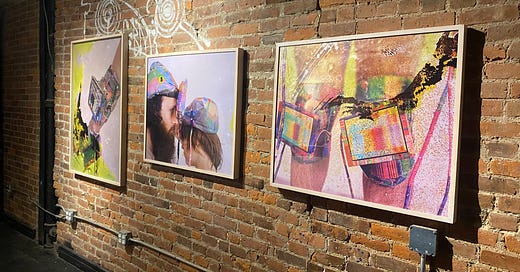In the Galleries
LoVid, Mycotechnology: The Work of Wires in the Age of Secondary Decomposition
Various/Artists
19 Essex Street
Through May 30th
Re-discovering old photos is an uncommon bliss. What’s more common is finding them dog-eared and faded. The logic of communication media to decay puts it at odds with the logic of the gallery as white-walled showroom. But those signs of use are often an added bonus for those who appreciate turning knobs, wrapping wires, and viewing, if not making, analog film scratches. Count LoVid (Tali Hinkis and Kyle Lapidus) among the lovers of tactility and haptics. Their handmade software tools included “wearables” long before that term became co-opted by corporate marketing firms to refer to fitness trackers and smartwatches. Various/Artist’s backroom gallery currently features rediscovered photographs from the 2000s that put this era of LoVid’s work on view. Shot in close-up view of the wearables, the photographs zoom in on rave-colored signals that have been encoded in both screens and fabric, wrapped around and shared between Kyle and Tali. It may take a glance or two to realize that these photos have been damaged—the “myco” in the title refers to fungi—since the acidic discoloration merges so well with the composition’s color and form. But what is damage other than the entropic forces that we and all our media are subject to? Making these photos public is an act of media ecology where loving a disappearing image implicates oneself, and one’s practice, with the Earth.
Marian Goodman Gallery
385 Broadway
Through June 21st
If you’ve read art and media theory journals—or just Grey Room—within the last five years, you’ve probably read about Pierre Huyghe’s work with generative AI. I was happy to see that some of these works have come to New York so that I can feel like I’m “part of the discourse” or whatever. I made the mistake of watching Andrei Tarkovsky’s Stalker the night before heading out to the sleepy, almost-empty gallery in the middle of the week. It was pretty unnerving to be in the upstairs gallery by myself with Huyghe’s automatons entering an architectural outpost similar to the untouchable, toxic zone of Stalker.
Anyway, I’m trying to compile a lit review about all that’s been said about Huyghe’s work with AI—most of it is praiseworthy—for a paper I have to write this fall for ASAP/16 , so I might drop some words about the exhibition in a future edition of Special Plastic Bags.
Public Discourse on Art and Art Criticism’s Disappearance
The Whitney ISP (Independent Study Program)’s Critical Studies fellows cancelled their May symposium in solidarity with the artists Noel Maghathe, Fadl Fakhouri, and Fargo Tbakhi whose performance for the ISP exhibition a grammar of attention was pulled by the Whitney Museum of American Art.
In lieu of speaking at the symposium, ISP fellow Genevieve Lipinsky de Orlov posted their talk about the “extra-institutional” on The Public Review. De Orlov addresses the difficulty of having criticality as a writer, critic, or artist when it remains outside the scope of institutions:
The question, then, not only of what criticism does or should do but also, crucially, where it can appear and circulate—be published or shared publicly—and how—the material conditions that make it possible—are urgent, and they’re in no way resolved.
Agreed, agreed, agreed. Independent publishing—and not the type of independence that’s in spirit or name only—is hard to come by. This hurts.
What helps, on a very small level, is knowing that there’s organizations that do help others publish and distribute on a small scale. Secret Riso Club is one of many of them.
Allergy Season
There’s a prescription pill for dust mite allergies?! In case you’re allergic—like me—and didn’t know about this option before today—like me—here’s a link from Harvard Health about sublingual immunotherapy (SLIT).
As always, thanks for reading and apologies for any typos/bad grammar.



